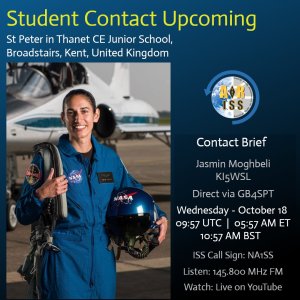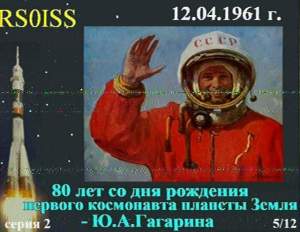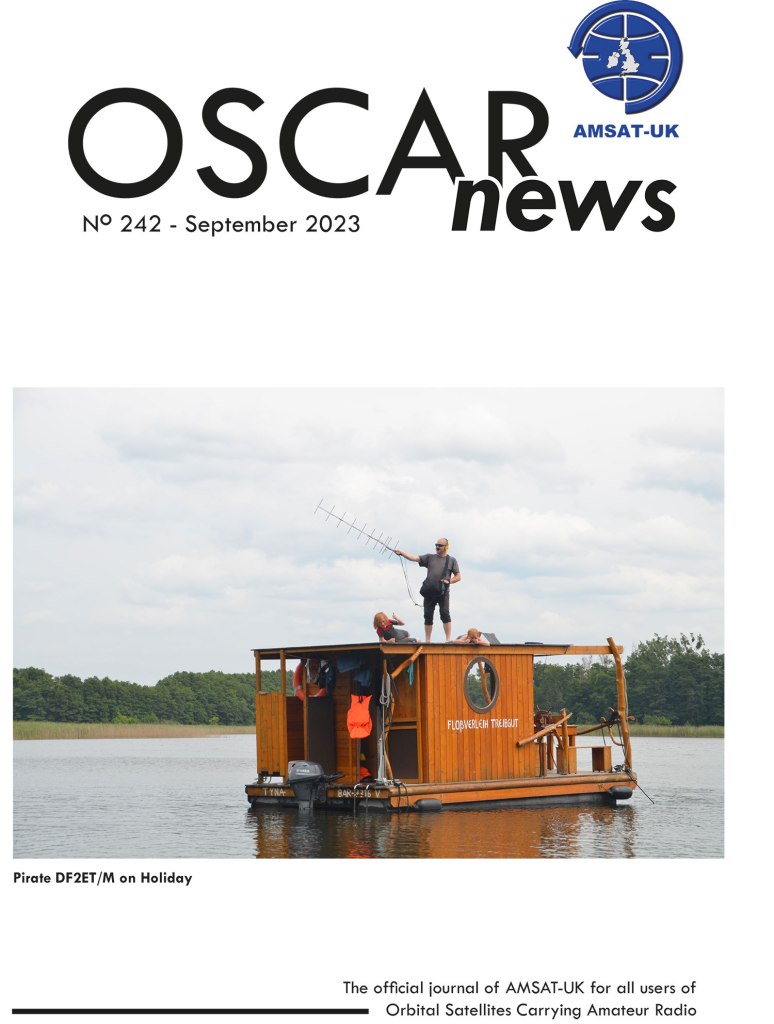 Amateur Radio on the International Space Station (ARISS) has received schedule confirmation for an ARISS radio contact between an astronaut aboard the International Space Station (ISS) and students at St Peter Junior School in Broadstairs, UK. ARISS conducts 60-80 of these special amateur radio contacts each year between students around the globe and crew members with ham radio licenses aboard the ISS.
Amateur Radio on the International Space Station (ARISS) has received schedule confirmation for an ARISS radio contact between an astronaut aboard the International Space Station (ISS) and students at St Peter Junior School in Broadstairs, UK. ARISS conducts 60-80 of these special amateur radio contacts each year between students around the globe and crew members with ham radio licenses aboard the ISS.
St Peter is a three form entry junior school located in Broadstairs, a small seaside town on the South East coast of England. St Peter’s students (ages 7 – 11) have been taking part in activities in ‘Mission Zero’ where they write a program to display a personalized image on an Astro Pi computer on board the ISS to remind the astronauts of home.
Students have also been taking part in the FUNcube project (tracking an active LEO Satellite – FUNcube-1/AO-73), and participating in a community stargazing event assisted by members of Ramsgate Stargazers. The school’s science club has also engaged students in space-related activities that include learning the difficulties of traveling to space, designing and launching rockets (using water and air), and living on the ISS (and designing solutions that may help overcome these difficulties). Members of the Hilderstone Radio Society (G0HRS) have been fundamental in advising and supporting the school during these activities and during this ARISS contact.
This will be a direct contact via Amateur Radio and students will take turns asking their questions of Astronaut Jasmin Moghbeli, amateur radio call sign KI5WSL. The downlink frequency for this contact is 145.800 MHz and may be heard by listeners that are within the ISS-footprint that also encompasses the relay ground station.
The amateur radio ground station for this contact is in Broadstairs, UK. Amateur radio operators using call sign GB4SPT, will operate the ground station to establish and maintain the ISS connection.
The ARISS radio contact is scheduled for October 18, 2023 at 10:57:49 am BST (UK) (9:57:49 UTC, 5:57 am EDT, 4:57 am CDT, 3:57 am MDT, 2:57 am PDT).
The public is invited to watch the live stream at: https://live.ariss.org
As time allows, students will ask these questions:
1. Is it hot or cold in space, and if it’s hot how do you keep cool and if it’s cold how do you keep warm in your spacesuit?
2. Is it really true that girls are better suited to space than boys?
3. How do you tell if it’s night or day on the international space station?
4. Would you be happy to live in space for the rest of your life if you were told to?
5. What are your thoughts about space travel in the future for mankind?
6. In the future will we be able to take holidays to the international space station?
7. Do you think living organisms will ever be found in space, and if so what could they be?
8. Do you get dizzy in space when you are not moving? Or does the lack of gravity mean that you do not get dizzy?
9. Does the ISS shake when a Soyuz spacecraft docks?
10. I know we can measure gravity, but what is gravity?
11. What is the furthest distance a human has travelled away from Planet Earth?
12. What would happen if you played on a swing in space?
13. What is the most amazing thing you have seen on earth from the space station?
14. How do fires behave in space?
15. Have you seen any comets?
16. How much work do you have to do on the space station each day, and what do you do in your spare time?
17. My brother and I love space, my brother especially loves the moon. We would love to be able to explore space one day. What advice can you give us, to help our dreams come true?
18. What did you study in school to become an astronaut?
19. How does the space station renew the oxygen inside the station?
20. What is different about growing plants in space and do you think we’ll be able to grow food for long term space missions?
21. Will there be a point soon when you can watch Netflix or use your mobile phone in Space – as you are near the satellites that operate the signals?
About ARISS:
Amateur Radio on the International Space Station (ARISS) is a cooperative venture of international amateur radio societies and the space agencies that support the International Space Station (ISS). In the United States, sponsors are the American Radio Relay League (ARRL), Amateur Radio Digital Communications (ARDC), Radio Amateur Satellite Corporation (AMSAT), NASA’s Space Communications and Navigation program (SCaN) and the ISS National Lab—Space Station Explorers. The primary goal of ARISS is to promote exploration of science, technology, engineering, the arts, and mathematics topics. ARISS does this by organizing scheduled contacts via amateur radio between crew members aboard the ISS and students. Before and during these radio contacts, students, educators, parents, and communities take part in hands-on learning activities tied to space, space technologies, and amateur radio.
 Amateur Radio on the International Space Station (ARISS) has received schedule confirmation for an ARISS radio contact between an astronaut aboard the International Space Station (ISS) and students at St Peter Junior School in Broadstairs, UK. ARISS conducts 60-80 of these special amateur radio contacts each year between students around the globe and crew members with ham radio licenses aboard the ISS.
Amateur Radio on the International Space Station (ARISS) has received schedule confirmation for an ARISS radio contact between an astronaut aboard the International Space Station (ISS) and students at St Peter Junior School in Broadstairs, UK. ARISS conducts 60-80 of these special amateur radio contacts each year between students around the globe and crew members with ham radio licenses aboard the ISS.




You must be logged in to post a comment.